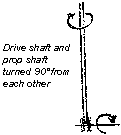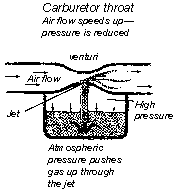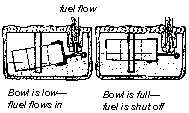Carburetors
| Engines need fuel, but also need proper amounts of oxygen to burn
the fuel. Carburetors mix air and fuel in the proper amounts to ensure
efficient combustion in the engine.
Only in outboard motor operation does the speed remain fairly constant. In chainsaws, four-wheel ATVs, and snowmachines, the engine speed is constantly changing. Mixing fuel and air properly at all rpms is a challenge. |
|||
|
Improper MixtureToo Much Fuel If there is too much fuel (too rich), combustion will not be complete, power will diminish, and carbon will quickly build up in the cylinder. Not Enough Fuel If an engine doesn’t get enough fuel (too lean), it will lose power, fade under load, and overheat. Proper mixture at all speeds is important. A lean engine, running too hot, is self destructing as parts warp, wear, and break. We must also remember that a two-cycle engine mixes the oil and fuel. An engine that is lean on fuel is also lean on oil. If it is lean on oil, friction does its irreversible damage. |
||
|
|
Parts of a Carburetor
Air Cleaner The air cleaner is an important part of the carburetor system, especially in chainsaws where there is so much sawdust in the air. If sawdust or dirt are drawn into the carburetor, the carburetor plugs up and sawdust quickly wears and destroys the engine. If the air cleaner is covered with dirt, the air supply is reduced and more fuel is drawn into the cylinder. The engine runs far too rich. An outboard isn’t operated in dusty conditions. Four-wheel ATVs and chainsaws need frequent attention. The air cleaner on a snowmachine can be covered with snow or frost. The throat of the carburetor is nothing more than a narrowed tube. When air passes through the narrow part, the air must speed up. Bernoulli’s principle says that as a liquid or gas speed up, the pressure is reduced. Because the velocity of the air in the carburetor throat is increased, the pressure is reduced. As the fast flowing air passes quickly over the high and low speed jets, fuel is pushed through the jets into the low pressure air stream from the bowl below. By the time the fuel is in the cylinder, it has been thoroughly mixed with the air (oxygen). |
||

|
Throttle Butterfly As the throttle cable is pulled, the butterfly opens and closes, controlling the airflow. The amount of air and speed of the air flowing over the jets is changed. Needle valves There is a screw that adjusts the amount of gas available to the jet. It is called the “needle valve” because the end of it is thin like a needle. Small adjustments of the screw allows precise amounts of fuel to pass the needle valve and go to the jet. Years ago, both the high and low speed needle valves were adjustable. Now, except on chainsaws, only the low speed needle valve can be adjusted. When an engine runs lean, the first thing people do is tinker with the needle valves. The main cause of fuel starvation is dirty fuel in the carburetor or a clogged fuel filter. Once an engine is tuned, it seldom needs needle valve adjustment except for extreme temperature differences. Most engines with two needle valves can be roughly adjusted by gently closing both needle valves, and opening 3/4 to 1 complete turn. The low speed valve is adjusted first, then the high speed. Choke A cold engine needs more fuel than a hot engine. The remedy for this is the choke. The choke reduces the area the airflow passes through. As with the throttle, the velocity of the air increases, and more fuel is pushed into the throat of the carburetor. When the engine is running and warm, the choke is no longer needed. Float or Other Regulating System Although carburetors are different in some aspects, the principles
they operate by are the same. There are basically two kinds of shut-off
systems:
Throttle cable The throttle cable is a stiff wire that slides within a covering. This attaches the throttle to the carburetor, so the operator is constantly in control of the speed of the engine. |
||

|
|||
Surface Area of Fuel If you split a dry block of wood into many small pieces, it will burn much faster than if it is burned in one whole piece. Liquid fuel, like gasoline, will burn quicker if it has more surface area. If a stream of gasoline is injected into the cylinder, it burns much slower than the same amount of gasoline that has been sprayed into a mist. Oil Injection Like snowmachines, newer outboard motors have oil injectors that mix the fuel and oil. The ideal oil/gas mix is different at high and low rpm’s. The oil injection varies the amount of oil at different speeds. |
|||

|
IcingHeat is required to turn a liquid into a vapor. Assume the carburetor, fuel, and air are at fifty degrees. The fuel is vaporized in the carburetor. It takes heat to evaporate a liquid to a vapor. The heat comes from the carburetor walls. As this process continues, the carburetor actually gets ten to fifteen degrees colder than the outside air. The carburetor cools the air passing through the carburetor throat. As warm air holds more moisture than cooler air, the air, now cooled in the carburetor, releases its moisture. It can actually form ice in a carburetor when the outside temperature is forty to sixty degrees! This is why airplane engines have a “carb heat” control to inject warm air, melting any ice formed in the carburetor. |
||

|
Activities
|
||

|
Student Response
|
||

|
Math
|


 There
are seven important parts of a carburetor.
There
are seven important parts of a carburetor.
 Throat
of the Carburetor
Throat
of the Carburetor
 It
is important that there is great surface area for the fuel to burn.
Burning can only take place on the surface of fuel.
It
is important that there is great surface area for the fuel to burn.
Burning can only take place on the surface of fuel.